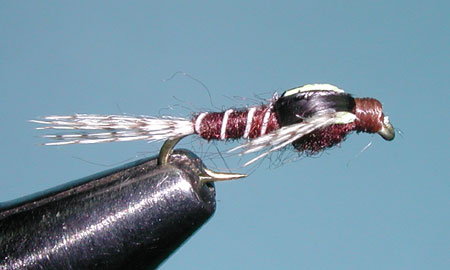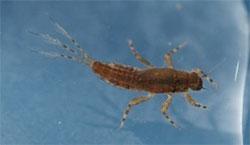

 Split Case, PMD Tying Instructions |
Materials:
(to Order Material, click the link)
Actual Pale Morning Dun Nymph 
|
|
Life Cycle: The Pale Morning Dun mayfly is a major hatch for our Sierran streams and rivers. They are found heavily within Spring Creeks and tailwaters, preferring stabilized flows and streambeds with rooted vegetation. Often the nymphs tend to be within the riffles and tailouts of runs or pools, crawling on the bottom. They tend to be unavailable to the trout until just prior to the hatch and become restless, moving about the streambed. The PMD begins its life cycle as a crawling type of nymph that crawls towards the streambanks before they swim clumsily to the surface when ready to "hatch". The nymph actually splits just below the surface and the dun emerges completing it's travel to the surface a few inches further. At the surface it takes some time, 7-10 minutes, for the wings to dry so that the dun can proceed out of the water for the nearest streamside vegetation. PMD's are generally in the size 16-18. The duns molt into spinners for mating with the females depositing eggs usually in the late afternoon. Rarely is the spinner fall a focus for the trout as they tend to concentrate on the emerging dun during the hatch as large numbers are usually present on the water surface. Hatches usually begin in late May or early June and continue to the end of July or early August. The water temperature should be between 58-62 degrees F for a good hatch to take place. The hatch usually starts in late morning around 11:00am. If it is a bright, warm day the hatch might go on for only an hour or more. On cloudy days, the hatch might continue for 3-4 hours and be sporadic. Timing the hatch is critical for good nymphing opportunities. Deep nymphing should start about 3 hours prior to the hatch using a beadhead Pheasant Tail Nymph, Iron Lotus, Mighty May, or Micro May. Once the hatch starts to show, continue to nymph within the middle of the water column, particularly in shallow- to medium-depth riffles. Mercer's PMD Trigger Nymph and Burk's HBI can be quite effective during these middle water column presentations, particularly when used as a dropper off a dun dry fly pattern. The dry fly will act as an indicator for placing the strike. During the middle of the hatch, when the duns are plentiful on the surface, using emerging nymphal patterns, such as the Split Case, will be the key. . . | ||